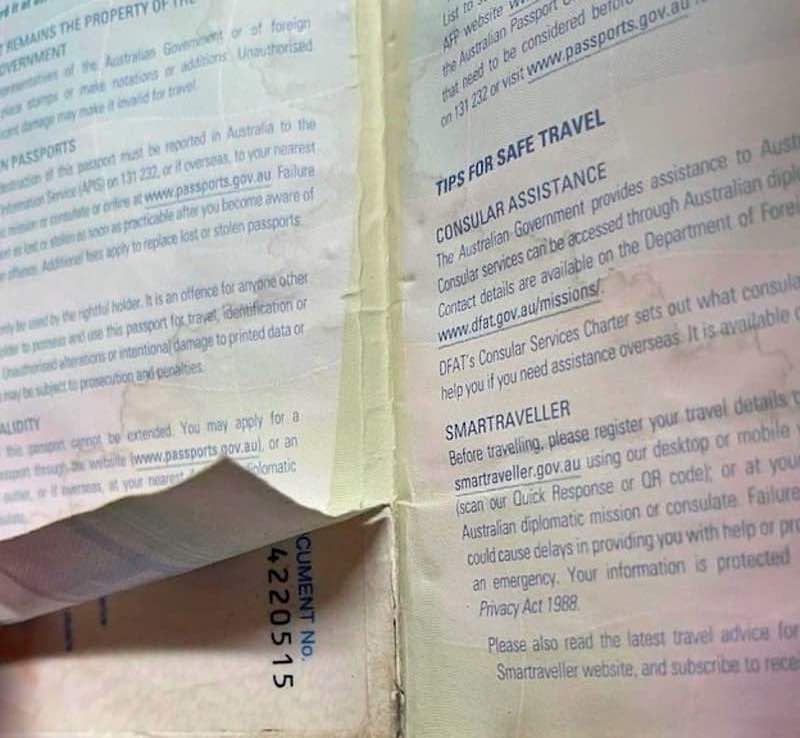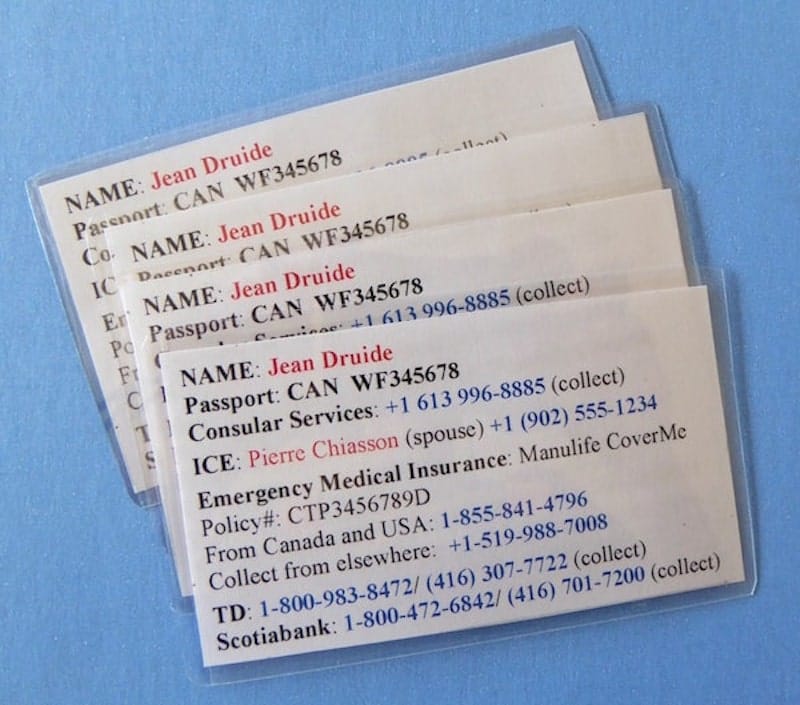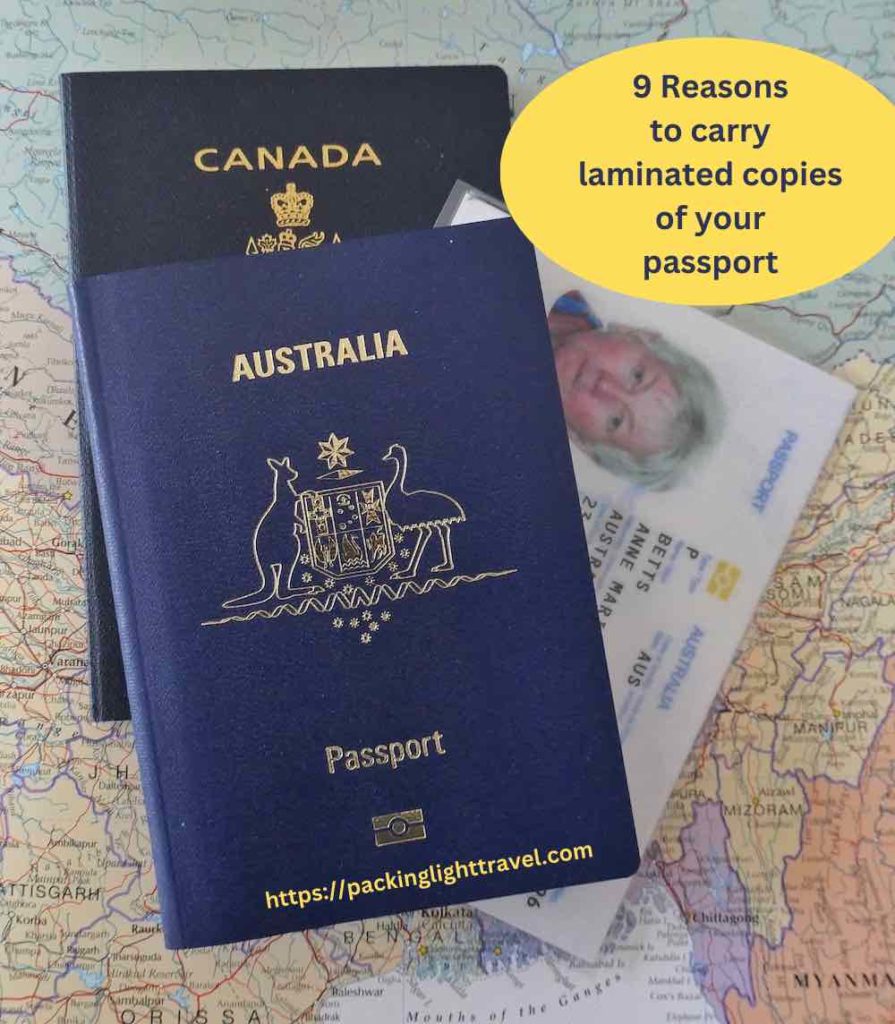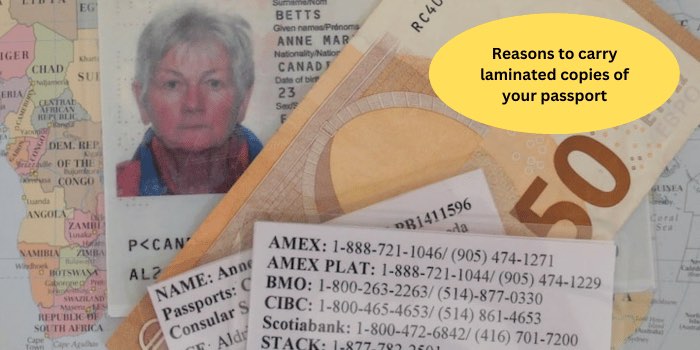Updated February 4, 2024
In my travels, there have been many occasions when I’ve been asked for my passport and a copy was all that was needed. As a result, I’ve learned that to carry laminated copies of your passport is a wise choice. It keeps a passport secure until there’s a valid reason for presenting it.
My recommendation is to make several copies, one for each bag, one to share with a travelling companion, and one to leave with stay-at-home family members. In addition, store a scanned copy in Dropbox or your email account.
Table of Contents
- 9 Tested reasons to carry laminated copies of your passport
- 1. It’s a form of identification in many situations
- 2. To establish your identity when you can’t speak for yourself
- 3. To help facilitate getting an emergency passport
- 4. It keeps your passport secure
- 5. It helps keep your passport damage-free
- 7. To avoid breaking the law
- 8. To get out of a jam
- 9. It may prevent extortion
- How to make laminated copies of your passport
- For additional security…
9 Tested reasons to carry laminated copies of your passport
By ‘laminated copies of your passport,’ I’m referring to copies of the information page, the one with your passport number, photograph, date and place of issue, and expiry date.
Why carry laminated copies of your passport?
1. It’s a form of identification in many situations
While it’s necessary to hand over an actual passport to a border services officer, there are many situations when a copy is adequate. I’ve been asked for my passport at hospitals, booking agencies, banks, mobile service providers, supermarkets, credit card terminals, and car rental agencies. In each case, a copy was acceptable.
I’ve used it to establish proof of age when seeking a discount, and have my identity checked against the permit required to hike Taiwan’s Old Zhuilu Trail. Many cities in Central and Eastern Europe offer free public transportation for seniors; in Warsaw, Prague, and Budapest, a laminated copy of my passport met the requirements of transportation workers.
2. To establish your identity when you can’t speak for yourself
If you’re in an accident and lost consciousness, a readily accessible copy of your passport provides first responders with your name, age, and citizenship. These can be invaluable in getting you medical treatment and consular support.
3. To help facilitate getting an emergency passport
If you ever have to apply for an emergency passport, some countries indicate that a copy of your lost or stolen passport will expedite the process. Some jurisdictions require the number of the original passport, date of issue, date of expiry, and place of issue. These particulars are at your fingertips when you carry a laminated copy of your passport.
4. It keeps your passport secure
Using a laminated copy is an opportunity to keep a passport in a secure, but somewhat inaccessible place. Some travellers advocate carrying their passport at all times in an under-clothing security pouch or a pickpocket-proof bag. Others prefer to leave it in a safe or safety deposit box at their accommodation. Whatever your preference, with a passport securely stowed or locked away, there’s less chance of loss or theft.
In some countries, the hotelier will want to keep your passport in order to record the necessary information to satisfy his or her legal obligations. For travellers who don’t like to be separated from their passports, it’s easier to hand over a laminated copy than to trust leaving the actual passport in the hands of stranger for several hours.
5. It helps keep your passport damage-free
A damaged passport limits your ability to travel. You could be denied boarding an aircraft or denied entry to a country. Examples of a damaged passport include:
- a loose or missing passport cover
- frayed or loose binding
- torn, worn, or curling edges of pages or covers
- warped, bent, or curved covers or pages
- unauthorized markings or stamps, not of official government agencies
- major or minor water damage
- worn or curling edges of pages
- Radio Frequency Identification (RFID) chip damage
Every time your passport is handed to a stranger, there’s a risk of damage. It could be stamped with a novelty stamp from a tourist attraction, dropped in a puddle, accidentally marked with a pen, or be the victim of coffee spills.
Travel + Leisure describes the plight of a UK passport holder who was denied boarding a Qatar Airways flight because of a novelty stamp from Machu Picchu in her passport. The holder of this Australian passport was denied boarding a Malaysian Airlines flight from Brisbane to Istanbul via Denpasar. It was a costly outcome: a ruined vacation and non-refundable trip expenses.

6. It saves time
In Cambodia, I was the first in line at the hotel registration desk. Our bike tour organizer had indicated we’d need to present a passport to check in to the hotel. While my cycling companions were rummaging in their gear for passports, I had already checked in with the aid of the laminated copy stored in an easily accessible pocket of my day bag.
Arrival and departure forms usually require details such as the passport number, date of issue, and expiry date – information that is rarely committed to memory. A laminated passport copy might be more accessible than your passport. Mine is.
7. To avoid breaking the law
In many countries, people are required by law to carry a valid form of identification at all times. For this purpose, and for other reasons, I always carry my Canadian drivers licence in a slot of my wallet phone case. While it’s uncommon to be asked for identification, there may be occasions when producing a laminated copy of your passport quickly satisfies the authorities of your identity, resulting in your ability to be on your way without unnecessary fuss.
8. To get out of a jam
In unfamiliar surroundings, stuff happens. A person might inadvertently break the law without realizing it. Here I was in a country where people drive on the other side of the road, and I was crossing a busy intersection with two sections. I saw the first “WALK” signal but not the second (that had changed to “DON’T WALK”) and besides, I was sticking close to another pedestrian who seemed to know what she was doing and crossing at the same time.
Waiting for both of us on the opposite footpath was a police officer demanding identification. I produced a laminated copy of my passport and was told to stay where I was with the comment, “I’ll deal with you in a moment.” Meanwhile, the other person was advised that her fine would arrive in the mail at the address listed on her identification. I escaped with a caution that the intersection was the scene of a recent fatality and a warning to be more vigilant at pedestrian crossings.
9. It may prevent extortion
When travelling to a country where corruption is tolerated, it would be useful to carry a laminated copy of your passport. Picture this scenario. It’s a random police (or fake police) stop and you’re asked for your passport. Is the stop designed to extort a bribe? Once your passport is in an extortionist’s hands, s/he may attempt to extort money from you before giving it back. A laminated copy might foil these efforts.
Keep a passport hidden until it feels safe to hand it over. Or suggest the officer (or fake officer) walks you to a nearby police station or to your hotel to retrieve it. At the hotel, there’d be a translator or witness who could likely confirm the legitimacy of the request. A real police officer with a legitimate reason to ask for your passport shouldn’t have an issue with either of these scenarios.
How to make laminated copies of your passport
The easiest and most efficient approach is to use the equipment and expertise of an office supply depot. In Canada, I used Staples.
Why?
- The store has a laser printer that makes copies in colour.
- A guillotine paper trimmer cuts straight edges. It’s more effective than my ruler-and-scissors effort at home. As a dual passport holder, I found it difficult to line up my back-to-back Australian and Canadian copies at home. At Staples, they lined up perfectly.
- Staples stocks different sizes of laminating sheets. It’s cheaper if a single sheet can be used for the number of copies you need.
- The four back-to-back copies of both of my passports cost less than $10 and will last for the 10-year life of my each of my passports.
For additional security…
Might you be interested in making a laminated emergency contact card? It’s the size of a credit card and contains information such as:
- name
- ICE (In Case of Emergency) contact name and telephone number
- citizenship and passport number
- emergency medical insurance policy number and telephone number
- consular services contact number
- telephone numbers of financial institutions’ credit and debit cards
If so, check out How to make a traveller’s emergency contact card in 5 easy steps. One of these cards is usually in the same place as the laminated copy of my passport.

If you found this post helpful, please share it by choosing one or more social media buttons. Do you carry a laminated copy of your passport? If so, when has it been beneficial? Please join the conversation in the comments below. Thank you.
For additional resources on being prepared to deal with emergencies, see
- 10 Best things to pack in case of a travel medical emergency
- 25 Ideas on how to assemble and emergency preparedness toolkit for travellers
- Features of an ideal wallet phone case for travel
- Emergency ID bracelet for travellers
Pin for later?







I save a copy of my passport to the Books App on my iPhone. I a.so save scans of the fronts and backs of my credit cards and my insurance cards. I keep copies of all travel, etc. insurance information there too. The iPhone is pretty secure.
The iPhone’s Health App has the ability to enter extensive emergency contact and health information. Best of all, it is available from the lock screen without a password.
Finally, I have a scan of my travel business card as wallpaper on my phone’s lock screen, so if the phone is lost, my name and email address are readily available.
Thank you Anna for adding value to the post with these excellent suggestions. Having this information at your fingertips in an emergency makes so much sense. Happy travels!!
@Anna I do exactly the same things as you
Thank you for this tip. I did this recently for my first award trip, and it was very convenient.
Great reasons to laminate a passport . I will definitely need to do this and keep it in a place I can get to quickly .
I’ve never thought of making laminated copies of my passport before but I can definitely see how useful it could be in these situations! I’m definitely doing this on my next trip, thank for the tip!
Wow, I honestly never thought about all this- thank you so much for the awesome tip!
Very wise tips! I do the same with my passport in certain countries, especially ones that require it like Russia. I think it’s better than saving the passport information to your phone in case the phone gets stolen.
This is actually a great idea! I don’t know what I would do if I lost my passport. I have a photo of it in my phone just to be safe though.
I couldn’t agree more with you on this post, especially with the part where a laminated copy helps with potential damages to our passport. Had I only thought of that during one of my trip to Asia, I guess my passport wouldn’t have suffered from extreme weather conditions. Great post, thanks for sharing!
This is a great idea, a laminated copy seems better than the paper copy I normally take with me.
What a helpful post, thank you! I do carry photo copies of our passports and credit card info with us when we travel but they are always pretty beat up by the end of the trip. Laminating the passport copies is a fabulous idea. I would only need to do it once, instead of making new copies for each trip. Thanks again!
Erica recently posted…The 20 Best Games for People Who Love to Travel
Ah! I had never really thought about keeping a laminated copy but you’ve convinced me to carry one the next time I travel. I do keep a digital copy handy but yeah it’s better to have a laminated copy too.
Yes, this is so smart! When I went to Europe I had a printed copy (will definitely laminate next time!) that I carried around with me. I ended up leaving my purse on a train and never getting it back and was SO relieved the only thing in there was my printed copy!
Such a very informative post! I always carry a copy of my passport; however, I never thought of laminating yet. Such a great tip. Will be doing that from here on out on my travels.
That’s a great idea, thanks
On a similar topic, my husband and I have our medical directives, power of Attorney, emergency contact, etc., on file with a company that provides this service. We carry a card in wallet (behind DL) with a contact number for company.
2 things wrong in this article. A copy, laminated or not, of your passport IS NOT a legitimate form of identification and having a copy of your passport will not make it easier, or streamline the process of re-issue, in the event of a lost or stolen document
Hi Bryan. Thank you for dropping by and leaving a comment. This post was on my update list and your comment was the motivation needed to do so. For clarity, I removed ‘legitimate’ from my previous version and added a few more reasons to carry laminated copies of the information page of a passport. You’re right; in some jurisdictions, having a copy of the lost or stolen passport won’t expedite the replacement process. For some countries it does. I’ve added a link for one country where it matters. Thanks again.
I’ve been carrying my passports in a plastic envelope that seals but that’s just not enough! Thank you for the info!!